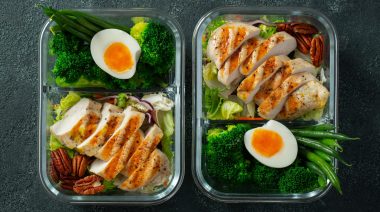At first, this might seem like a rhetorical question, but have you really ever asked yourself, “Why am I eating this way?” Are you an Olympic athlete looking only to optimize performance over all other variables? Are you a recreational athlete that wants to look great on the beach? Maybe you are a jockey, and weighing as little as possible is almost the only thing that matters.
Regardless of your food choices, from unconscious omnivore to vegan or anywhere in between, if you have a vision of yourself that is different from what you are today, you are going to have to do something differently than what you have done in the past. Are you with me so far? Okay, good. Keep reading.
Learning how to create and pursue a vision using proven tools and techniques, rather than trudging along but getting nowhere like Conan on the mill wheel, can help you achieve a new level of self-control and determination.
For Body Composition, Calories Matter
First, I’m sure you’ll agree, we need to start with a basic set of relevant facts. Just as a physicist cannot discount the law of gravity, and an economist cannot choose to ignore supply and demand, we cannot operate outside of the basic laws that govern the human body.
The painstaking process of dispelling food myths has been undertaken by others many times, and to their great peril. I will not repeat their mistakes. Instead, I will make a series of statements of fact, the understanding and internalization of which your success depends upon. Go with the positive, right?
- Calories in versus calories out is valid on some level.
- More movement means more calories expended.
- Failing to plan is planning to fail.
- Consistency is key.
- There are no shortcuts.
How much you eat does matter. To wit: If I can plainly see that eating too little has an effect, how is eating too much different? It’s a rare person who would argue that going on a three-day backwoods hike would not warrant bringing food along. Likewise, if one is not going on a grueling three-day hike, equal calories would not be required.
But, Somebody Told Me…
Some in paleo circles have put forth the notion that portion size and total calories are made irrelevant by dispensing with Neolithic foods. Still others argue that timing of calories makes all the difference. As I sit here watching Animal Planet, the bear getting ready to hibernate is having a different experience. Regardless of food type or quality, there is a relationship between caloric intake and body composition.
I don’t believe I have to defend, or remind you of, the truth of the remaining items on the list. Should you have questions about the other bullet points, please ask them in the comments.
Be a Visionary
Goal setting is nearly dead. It has been intubated, but the relatives are moving to pull the plug. I scarcely need to say more, but I will in case you are behind the times. Goals simply don’t work the way we were told they do. Goals do not inspire us. In fact, failure, even the fear of failure, to achieve milestones creates negative emotions that reduce intrinsic motivation. I don’t know about you, but I can use all the intrinsic motivation I can get.
Okay, goals are dead. What now? Try creating a vision instead. Unlike a goal, which requires you to write a plan that includes demotivating check-in points along the way and fails to inspire, a vision almost creates a plan for you and pulls you along every step of the way. Instead of telling you that you’re a failure for falling behind, the way a goal does, a vision congratulates you for another day of good behavior.
Create Your Vision
How to create a vision for yourself is the topic of another article, but I’ll get you started. A vision is built around a desired feeling or set of feelings, around fulfillment and satisfaction. Every day that you pursue your vision, you are rewarded with a bit of that satisfaction and fulfillment.
I did 300 kettlebell swings today. An actionable part of a vision of myself as a person who did 9,000 kettlebell swings in one month. Visions drive behavior, while goals demand it. Chasing a hundred-dollar bill on a windy day is a lot more fun, and more inspiring, than being told to flip burgers for twelve hours.
Now that you know why you want a vision of your success, it’s easy to create that vision. Many of the most successful people in history became successful because they relentlessly pursued a grand vision. Create your own grand vision now. Grand as in grandiose. Delusional level. With intricate detail. The more grand and detailed, the better. You are building an inspiration engine that will propel your life toward your vision. Rome wasn’t built in a day, but it was probably conceived in five incredible minutes.

Live Your Vision
Take a look at your vision and see how it differs from who you are today. Maybe you appear more muscular, maybe you can jump higher. Perhaps you have lower blood pressure and reduced anxiety. It can be anything you can imagine.
Let’s say that your vision of yourself is leaner and more muscular than you are now. Create a template for your nutrition that matches your vision and inspires a behavior change. I will use a simplified approach (albeit one that often works to get started) for caloric need calculation in this example. Here it is:
- Calculate basal metabolic rate (BMR) by multiplying lean mass in pounds by twelve for women and by fifteen for men. Add to this if you have an exceptionally active job.
- Add appropriate calories to cover workout activities.
- Add up weekly caloric needs and divide by seven.
- Add to, subtract from, or do not change the result according to your vision.
Here it is using actual numbers:
- Nancy’s vision is to look a certain way in a bikini. She knows that this means having a low-ish body fat percentage (BF%) as well as a decent amount of muscle mass to fill out her frame. Currently, her BF% is higher than she’d like it to be and she has less muscle than her vision of herself does. If Nancy is working with a good coach, her coach can insulate her from these numbers if she’d prefer, as they are only needed for calculations.
- Nancy currently weighs 169 pounds and carries 38% body fat. That leaves Nancy with about 105 pounds of active tissue to feed.
- 105 pounds X 12 calories per pound = 1,260 calories
- Nancy trains 4 times per week, expending about 360 calories each time she trains.
- 1,260 X 7 + 360 X 4 = 10,260 / 7 = 1,466 calories per day
- Since Nancy wants to add muscle and lose fat at the same time, we’re going to leave her calories right there for the first month, then reevaluate.
A variety of methods are useful for tracking caloric intake. Weighing and measuring is a tried-and-trued method for driving oneself crazy, but is effective and useful if you have no baseline at all for what a cup or a pound or a tablespoon of something looks like. It gets old fast, though, and can also trigger negative feelings, emotions, and behaviors in people with a history of eating disorder.
Nancy is going to log her food for two weeks and bring her eating behaviors in line with her vision. When done this way, it is far more natural than setting goals and creating a “win or lose” atmosphere around one of the most basic human functions. Would you create numeric goals around sex?

Nancy can use a mobile app to track her calories if she wants to. Often, it’s easier than trying to remember everything each day. By putting in 1,466 as her daily calorie target and eating until she gets to that point, but not beyond, it soon becomes automatic. As her body changes, though, so will her caloric needs. Adjustments need to be made regularly based on whether she is approaching her vision or moving away from it.
Using a template allows you to follow any eating protocol and preference (or lack of preference!) and still be working toward your vision. Meal timing, food choice, and macronutrient ratios also have an effect, but until quantity is dialed in, the effect of other variables may be more difficult to notice. If this seems like too much to think about, welcome to the club. Rather than get derailed, get a coach.
Vision drives and rewards behavior, goals crush motivation. Be a visionary.
Stay tuned for more on vision and achievement for other purposes in the future, both here at Pulse Beat Fit and at the 300 Swings Facebook page.
Photos 1 & 2 courtesy of Shutterstock.






